Galaxy S10 vs. Pixel 3: Which Android Phone Is Best?
Here's how these Android heavyweights stack up
Samsung is used to dominating the Android smartphone market with its Galaxy S and Note phones commanding the lion's share of attention and sales. In recent years, though, other Android phone makers have made strides in knocking Samsung off its game, with Google in particular causing some sweaty brows around Samsung headquarters.
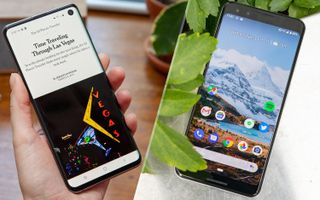
Google's Pixel phones have risen up the ranks of Android devices, thanks to the Pixels' superior cameras and pure Android experience. The Pixel 3 and Pixel 3 XL are good examples of this, offering smartphone shoppers the best camera phone when they debuted in the fall of 2018. (The Pixel 4, released this past fall, improved on the cameras even further, though we think the iPhone 11 Pro is the best camera phone you can get at the moment.)
But Samsung is clearly up for the challenge. Earlier this spring, the company rolled out a new Galaxy S10 lineup that not only introduces improved cameras and a new UI, but also upgrades the processor and the look of Samsung's flagship phones.
Are these changes enough to vault the Galaxy S10 ahead of the Pixel 3? As you consider whether to get Samsung's latest flagship or opt for a lower-priced Pixel model, here's a closer look at how the different versions of the Galaxy S10 and Pixel 3 compare.
| Phone | Galaxy S10e | Galaxy S10 | Galaxy S10 Plus | Pixel 3 | Pixel 3 XL |
| Debut Price | $749 | $899 | $999 | $799 | $899 |
| Screen Size (Resolution) | 5.8 inches (2160 x 1080) | 6.1 inches (3040 x 1440) | 6.4 inches (3040 x 1440) | 5.5 inches (2160 x 1080) | 6.3 inches (2960 x 1440) |
| CPU | Snapdragon 855 | Snapdragon 855 | Snapdragon 855 | Snapdragon 845 | Snapdragon 845 |
| RAM | 6GB, 8GB | 8GB | 8GB, 12GB | 4GB | 4GB |
| Storage | 128GB, 256GB | 128GB, 512GB | 128GB, 512GB, 1TB | 64GB, 128GB | 64GB, 128GB |
| MicroSD | Yes, up to 512GB | Yes, up to 512GB | Yes, up to 512GB | No | No |
| Rear Cameras | 16 MP (f/2.2), 12 MP (f/1.5, f/2.4) | 16 MP (f/2.2), 12 MP (f/1.5, f/2.4), 12 MP (f/2.4) | 16 MP (f/2.2), 12 MP (f/1.5, f/2.4), 12 MP (f/2.4) | 12 MP (f/1.8) | 12 MP (f/1.8) |
| Front Cameras | 10 MP (f/1.9) | 10 MP (f/1.9) | 10 MP (f/1.9), 8 MP (f/2.2) | 8 MP (f/2.2), 8 MP (f/1.8) | 8 MP (f/2.2), 8 MP (f/1.8) |
| Battery | 3,100 mAh | 3,400 mAh | 4,100 mAh | 2,915 mAh | 3,430 mAh |
| Battery Life (Hrs:Mins) | 9:41 | 10:19 | 12:35 | 8:27 | 9:30 |
| Size | 5.6 x 2.75 x 0.3 inches | 5.9 inches x 2.77 x 0.3 inches | 6.2 x 2.91 x 0.3 inches | 5.7 x 2.7 x 0.3 inches | 6.2 x 3 x 0.3 inches |
| Weight | 5.3 ounces | 5.5 ounces | 6.17 ounces | 5.2 ounces | 6.5 ounces |
| Colors | Flamingo Pink, Prism Black, Prism White, Prism Blue, Prism Green, Canary Yellow | Flamingo Pink, Prism Black, Prism White, Prism Blue, Prism Green | Flamingo Pink, Prism Black, Prism White, Prism Blue, Prism Green, Ceramic White, Ceramic Black | Clearly White, Just Black, Not Pink | Clearly White, Just Black, Not Pink |
Design
You get a full range of sizes when you're open to either a Pixel 3 or a Galaxy S10, with Google offering 5.5- and 6.3-inch models while Samsung sells Galaxy phones with 5.8-, 6.1- and 6.4-inch displays. While the Pixel 3 has the smallest screen size, the Galaxy S10e is actually the more compact phone, at 5.6 x 2.75 x 0.3 inches. The Pixel 3 is taller, though a fraction of an inch less wide. On the opposite end of the spectrum, the Galaxy S10 Plus is a little less wide than the Pixel 3 XL (2.9 inches vs 3 inches).
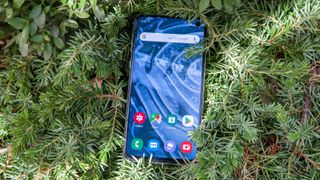
The larger Pixel and Galaxy phones take different approaches to maximizing screen real estate. For the Pixel 3 XL, there's a notch that dips down into the front of the screen, housing that phone's two front cameras. (The Pixel 3 skips the notch in favor of more-traditional bezels on its top and chin.)
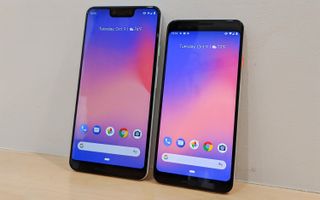
All of the Galaxy S10 models use a punch hole to house the front cameras, with the S10 Plus sporting two punch holes for its dual shooters. The look you prefer comes down to personal preference, but the Infinity O display on Samsung's phones is less distracting than the Pixel 3 XL's fat notch.

The Galaxy S10 and S10 Plus also save screen real estate via an ultrasonic fingerprint sensor that lives under the display. (The Galaxy S10E is an exception here, incorporating its sensor into the power button on the phone's side.) Using a front-facing sensor to unlock your phone feels a little bit more natural than reaching around the back of the device to place your finger on the phone's fingerprint sensor, as you have to do with the Pixel 3 or 3 XL. The ultrasonic fingerprint sensor on the S10 and S10 Plus also performed well in our testing.
Samsung's phones enjoy one other edge over the latest Pixels. All three Galaxy S10 models include a headphone jack; the Pixel 3 and 3 XL do not, though Google at least now bundles a pair of headphones that plug into the device's USB-C port.
Winner: Galaxy S10
Display
Both the Galaxy S10 and Pixel 3 models use OLED screens, though not all OLED panels are created equal. As a company that also has a thriving display business, Samsung enjoys an edge over other phone makers, and the Dynamic AMOLED screen the company uses on the Galaxy S10 is one of the best displays we've ever seen on a smartphone, with enhanced brightness and reduced emission of blue light, which can cause eye strain.

The Pixels top Samsung's new phones on color range, with the Pixel 3 covering 202 percent of the sRGB spectrum, compared to 148 percent and 136.5 percent for the S10e and S10 Plus, respectively. That may be the result of Samsung's phones defaulting to a Natural color setting that's designed to be more realistic.

The S10 Plus renders those colors more accurately, though, with a Delta-E score of 0.29. That's ahead of the Pixel 3 XL (0.35) and Pixel 3 (0.44). (Numbers closer to 0 are better.) The Galaxy S10e fared the worst on this test, with a Delta-E rating of 0.57.
The screens on Google's older Pixels struggle with brightness, with the Pixel 3 barely topping 401 nits when we measured it with a light meter. That's still better than the Pixel 3 XL and its 362-nit result. Suffice it to say, Samsung's phones outshine the Pixels, with the Galaxy S10e reaching 603 nits while the S10 Plus hit 625 nits when we shone a flashlight at its sensor. Still, you won't have to worry about making out what's on the S10's display in bright sunlight.
Winner: Galaxy S10
Cameras
Google has established the Pixel as the standard-setter for smartphone cameras, and it's not just hardware that sets these phones apart. As smartphone makers cram more lenses onto their devices — both the Pixel 4 and Pixel 4 XL feature two rear shooters as a matter of fact — the Pixel 3 and 3 XL offer just a single rear camera: a 12-megapixel lens with an f/1.8 aperture and both optical and electronic image stabilization. Up front, the Pixels turn to two lenses; accompanying the standard 8-MP shooter, there's an 8-MP, wide-angle lens for squeezing more people into selfies.

It's software, though, that sets Pixel photography apart, with Google leaning heavily on AI-powered features and computational photography to handle tasks like stylish background blurs. Pixel 3 camera highlights include Night Sight, which takes sharp, colorful pictures when the lights are low, and Top Shot, where AI-powered smarts select the best photo from a burst of exposures.
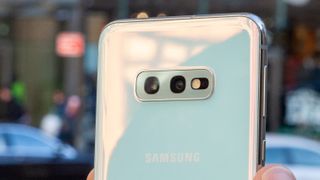
Samsung is challenging the Pixel's dominance by turning to more lenses. The Galaxy S10 and S10 Plus feature a three-camera setup on the back, with a 12-MP telephoto lens joining a 12-MP dual-pixel, wide-angle shooter and 16-MP ultra-wide-angle lens. The Galaxy S10e has just two cameras — there's no telephoto lens here — but even that's one more rear shooter than you'll find on the Pixel. Only the S10 Plus matches the Pixel's dual-front-camera approach, though that second lens is a depth-sensing camera meant to produce better portrait effects.
MORE: Best Android Camera Apps - Take Better Pictures on Your Phone
The S10 offers its share of software tweaks, too. Live Focus effects let you play around with everything from color to blurs, and improved AI lets the S10's camera recognize 30 different scenes to optimize its settings on the fly (though not always instantaneously in our testing).
We pitted the Galaxy S10 Plus against a Pixel 3 XL to see how their respective cameras compared. In a photo of some colorful hats taken outside on a busy San Francisco street, the triple lenses on Samsung's phone capture sharper detail, such as the woven fabric. The colors are more natural, too, as the Pixel 3 XL kept things a little darker for the sake of a more-even exposure.
Moving indoors to take a close-up of a cupcake, both cameras produced a striking shot. We prefer the Pixel 3 XL's result, thanks to the way it re-created the texture on the cupcake's frosting. The way it handles white balance is a little more pleasing to the eye, too, as the Galaxy S10 Plus' photo has more of a yellow cast to it, which impacts the color of the shot. That said, the S10 Plus does a better job keeping the shadows light in this photo.
You can see the benefit of the Galaxy S10's extra lenses when we tested out portrait shots. The one taken by the S10 Plus manages to include more of the background, which helps the subject of the photo pop out of the scene. The Pixel 3 XL's photo is a little too dark for our tastes, as well.
Speaking of darkness, this is where the Pixel asserts its dominance. The S10 Plus does a decent job getting some color out of the pitch-black room. But more background details are visible in the Pixel's Night Sight-aided shot.
Moving up front, the dual cameras on the Galaxy S10 Plus handle the background blur well enough, though it intrudes too much on the subject in the foreground. The S10 also smooths out faces in an unnatural way.
The S10 cameras are a big improvement over past Samsung efforts, and in a few areas, the latest Galaxy phones produce better photos than what you'll get from the current Pixels. Overall, though, Google's phone still enjoys an edge, particularly when the lights are low.
Winner: Pixel 3
Performance
Comparing the performance of the various S10 and Pixel 3 models comes down to a tale of two Snapdragons. Released in 2018, the Pixel 3 and 3 XL run on that year's top-of-the-line Qualcomm chipset, the Snapdragon 845. But because the Galaxy S10 is brand-spanking new, it has the advantage of a more recent mobile processor, the Snapdragon 855.
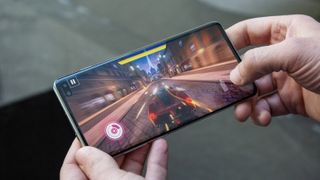
That gives Samsung's phones a significant edge. Qualcomm says the Snapdragon 855 delivers the biggest performance increase ever for one of chip maker's processor upgrades, and based on our S10 benchmarking, we're inclined to agree.
MORE: Android Q Beta Ready for Pixel Phones: How to Get It
The Galaxy S10 Plus turned in a multicore score of 10,732 on Geekbench 4, which measures general performance — the best score we've ever recorded for an Android phone. Lest you think that's the S10 Plus' 8GB of RAM doing the heavy lifting, the Galaxy S10e tallied a score of 10,513, and the model we tested came with 6GB of RAM.

Both those scores far outpace what Google's best phones produced. The Pixel 3 XL recorded a 7,684 score on Geekbench 4, while the Pixel 3 finished at 7,316.
The results were the same when we tested graphics using 3DMark's Sling Shot Extreme benchmark. The Galaxy S10 Plus' score of 5,486 topped marks from both the Pixel 3 (4,400) and 3 XL (4,396).
The Galaxy S10 Plus also improved upon the Pixel phones' performance in a real-world test in which we transcode a 4K video to 1080p. It took Samsung's new phone 2 minutes, 26 seconds to finish the task, so the Galaxy beat the Pixel 3 XL by 16 seconds.
Google's phones are no slouch on performance, and when issues have arisen with the Pixel 3, Google has rolled out software fixes in pretty short order. But the Snapdragon 845 inside the Pixel 3 and 3 XL just can't keep pace with the improved Snapdragon 855 powering Samsung's latest devices.
Winner: Galaxy S10
Battery
For a while, the Pixel 2 XL was one of the longest-lasting flagship phones you could get, topping 12 hours on our battery test. (We set the display brightness to 150 nits and then surf the web over LTE on the phone until it runs out of battery.) The Pixel 3 and 3 XL took a step back, though, with those phones turning in below-average times of 8:27 and 9:30, respectively.

The Galaxy S10 Plus puts those phones to shame when it comes to longevity, taking advantage of a 4,100-mAh battery. (The Pixel 3 and 3 XL feature 2,920-mAh and 3,520-mAh power packs, respectively.) The bigger battery helped the S10 Plus turn in a time of 12:35, beating the Pixel 2 XL by half an hour. The Galaxy S10e produced a more pedestrian time of 9:41, which was still better than the results from either Pixel 3 model, while the Galaxy S10 lasted for a better-than-average 10:19.
MORE: Longest-Lasting Smartphones
Samsung's phones have another trick up their sleeve for power management. Like Google's Pixel phones, the S10 lineup supports wireless charging. But the Wireless PowerShare feature found in each S10 model also lets you turn your Samsung phone into a wireless charging pad. Just place a device that uses the Qi standard to charge wirelessly on top of an S10, and you can power up that device.
The Pixels can charge up quickly, with support for 18-watt fast charging with the included cable. Buy a Pixel Stand, and you can charge your Google phone wireless at 10 watts. The Galaxy S10 also supports fast wireless charging on supported devices.
Winner: Galaxy S10
Software and Special Features
Because Google enjoys total control over the software side of things, it can debut features on the Pixel you just can't get on other Android devices (at least, until Google inevitably rolls out those features to other Android phones). For the Pixel 3, those special features come powered by Google's prowess with machine learning.

The Google Assistant on the latest Pixel can detect when spammers are calling you; the assistant will then field the call on your behalf, so you don't have to waste time talking to telemarketers pushing dubious vacation and credit card offers. Google's Duplex technology, which allows the Google Assistant to make restaurant reservations for you, also debuted on the Pixel 3, though Google's rolling the feature out to other phones now.
The Galaxy S10 looks to liven things up with Samsung's OneUI interface. (An updated version, OneUI 2.0, is in beta and coming to the Galaxy S10 shortly.) We're not big fans of the rounded icons that OneUI introduces; they look a little simple for our tastes. But the dynamically responsive interface gets rid of a lot of on-screen clutter, and that makes the S10 models easier to use with just one hand, thanks to strategically placed menus.
Both the Pixel 3 and Galaxy S10 ship with Android 9 Pie installed. Because Google runs the show, though, you're going to get software updates faster if you have a Pixel — the Pixel 3 is already able to run Android 10, while that software has not yet rolled out to the S10.
Winner: Pixel 3
Value
Originally, Samsung's phones offered the lowest starting price, at $749, but that's for the Galaxy S10e and not for the fuller-featured S10 and S10 Plus. The Pixel 3 originally cost $50 more than the S10e, though prices on Google's phones have fallen since the Pixel 4 came out.

As of this moment, you can get a Pixel 3 for $499 and a Pixel 3 XL for $599. Those are $300 discounts from their debut prices in 2018.
Meanwhile, the Galaxy S10 starts at $899 and the Galaxy S10 costs $999, though Galaxy S10 deals can save you money on those prices. Note that the S10 base models feature 128GB of storage, which is double the capacity on the Pixel 3 base models.
Google's Pixel phones are now available from more carriers, though it's harder to find the older Pixel 3. You'll find that phone at Sprint, Verizon and and Google's own Google Fi wireless service. (Only the Pixel 3 XL remains available at Google Fi, though.) The Galaxy S10 enjoys wider availability, as you can get it from all four major wireless providers, as well as regional carrier U.S. Cellular and the Xfinity Mobile service for Comcast customers. Samsung sells its phones through retailers like Best Buy, Amazon and Walmart, too.
Winner: Galaxy S10
Bottom Line
| Galaxy S10 | Pixel 3 | |
| Design (10) | 9 | 7 |
| Display (15) | 14 | 12 |
| Cameras (20) | 17 | 19 |
| Performance (15) | 14 | 12 |
| Battery (20) | 17 | 14 |
| Special Features (10) | 7 | 9 |
| Value (10) | 8 | 7 |
| Total (100) | 86 | 80 |
The Pixel 3 remains the phone to get if you want a great camera in your smartphone but don't want to pay full price for a newer flagship. Google's control over Android means that Pixel users get the purest Android experience on any handset. But it's clear that the better Android phone overall is the Galaxy S10.
Samsung's phone offers much better performance and — if you opt for the Galaxy S10 Plus — long battery life. The S10 lineup offers a more striking design and the best display we've seen yet on an Android phone. New features like Wireless PowerShare and an in-display fingerprint sensor on both the S10 and S10 Plus raise the bar for other phone makers. Even the lower-cost S10e doesn't force you to make too many compromises for a more affordable phone.
As good as the Pixel 3 and Pixel 3 XL are — and Google's phones have plenty in their favor apart from those superior cameras — the Galaxy S10 lineup sets the standard for Android devices in 2019.
Credit: Tom's Guide
Sign up to get the BEST of Tom’s Guide direct to your inbox.
Upgrade your life with a daily dose of the biggest tech news, lifestyle hacks and our curated analysis. Be the first to know about cutting-edge gadgets and the hottest deals.
Philip Michaels is a Managing Editor at Tom's Guide. He's been covering personal technology since 1999 and was in the building when Steve Jobs showed off the iPhone for the first time. He's been evaluating smartphones since that first iPhone debuted in 2007, and he's been following phone carriers and smartphone plans since 2015. He has strong opinions about Apple, the Oakland Athletics, old movies and proper butchery techniques. Follow him at @PhilipMichaels.

